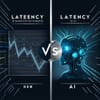Latency is a critical concept in both quantitative finance and artificial intelligence, but its implications and management differ significantly between the two fields. In quantitative finance, latency refers to the time delay between receiving market data and making a trading decision. This delay can be detrimental to trading firms, as even the slightest advantage in speed can result in significant financial gains.
To mitigate latency in quantitative finance, firms employ specialized hardware like Field Programmable Gate Arrays (FPGAs) and Application Specific Integrated Circuits (ASICs) to minimize response times. However, with the increasing complexity of models, general-purpose GPUs are becoming a viable alternative. For instance, NVIDIA's A100 Tensor Core GPU has demonstrated low-latency performance in LSTM model inference, making it suitable for modern trading environments.
In contrast, latency in AI refers to the time delay between input and output, affecting user experience and system performance. There are several types of latency in AI, including compute latency, network latency, and end-to-end latency. Compute latency is influenced by model complexity and hardware capabilities, while network latency is critical for real-time applications.
To manage latency in AI, strategies such as model optimization, hardware acceleration, data preprocessing, and distributed systems can be employed. Model optimization involves simplifying models through pruning and quantization to reduce computational load. Hardware acceleration utilizes GPUs, TPUs, or custom accelerators like ASICs to enhance processing speed. Data preprocessing streamlines data cleaning and feature extraction to minimize delays, while distributed systems leverage edge computing or distributed architectures to reduce latency.
Understanding the sources of latency and implementing these strategies can significantly enhance AI system performance and user experience. By minimizing latency, AI systems can provide faster and more accurate responses, leading to improved decision-making and increased productivity.


